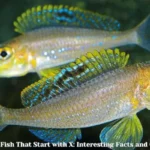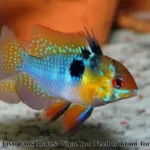Fish and fish varieties
4 Line Pictus Catfish: Feeding Habits and Nutrition Needs
The 4 Line Pictus Catfish, also known as Pimelodus blochii, is a fascinating species native to the freshwater rivers and streams of South America, primarily found in the Amazon Basin. This catfish is highly sought after by aquarium enthusiasts due to its unique appearance, characterized by the distinct four lines running along its body, and its active, energetic behavior. However, to keep these fish healthy and thriving in a home aquarium, it’s essential to understand their feeding habits and nutritional needs. This article, Elegant Aquriums will delve into these aspects, providing a comprehensive guide for fishkeepers who want to ensure their 4 Line Pictus Catfish are well-nourished and content.
Understanding the Natural Diet of 4 Line Pictus Catfish
In the wild, the 4 Line Pictus Catfish is a nocturnal predator, primarily feeding on a diet of small fish, invertebrates, and plant matter. Their diet is diverse and opportunistic, allowing them to adapt to various food sources available in their environment. These catfish are equipped with a keen sense of smell and sensitive barbels that help them locate food in the dark or murky waters where they usually reside.
Carnivorous Tendencies
The carnivorous nature of the 4 Line Pictus Catfish means that they prefer animal-based foods. In the wild, they often hunt small fish, worms, insects, and crustaceans. Their sharp teeth and agile movements make them effective hunters, even in challenging environments. This predatory behavior is an essential aspect of their feeding habits, and it’s something that needs to be considered when feeding them in an aquarium setting.
Omnivorous Adaptability
While they have a strong preference for meaty foods, 4 Line Pictus Catfish are also known to consume plant matter and detritus. This omnivorous adaptability allows them to survive in environments where animal prey may not be as abundant. They may graze on algae, fallen fruits, and other plant material, making them less dependent on a single food source. This adaptability is crucial for their survival in the wild and provides a hint for their dietary needs in captivity.
Feeding 4 Line Pictus Catfish in Captivity

When keeping 4 Line Pictus Catfish in an aquarium, replicating their natural diet as closely as possible is essential for their health and well-being. These fish are known for their fast metabolism and active nature, requiring a diet that is not only nutritious but also varied to keep them satisfied.
Commercial Fish Foods
Commercial fish foods are often the most convenient option for feeding 4 Line Pictus Catfish in captivity. High-quality sinking pellets or wafers specifically designed for carnivorous or omnivorous fish are ideal. These foods typically contain a mix of fish meal, shrimp, and other animal proteins, providing a balanced diet that meets their nutritional needs.
- Sinking Pellets: Sinking pellets are a staple in many aquariums, especially for bottom-dwelling species like the 4 Line Pictus Catfish. These pellets sink to the bottom of the tank, where the catfish can easily find and consume them. It’s important to choose pellets that are high in protein and suitable for carnivorous fish.
- Wafers: Wafers are another excellent option, particularly those that contain a mix of animal and plant-based ingredients. These can help mimic the catfish’s natural diet, providing a balanced nutrition profile.
Frozen and Live Foods
In addition to commercial foods, incorporating frozen or live foods into the diet of 4 Line Pictus Catfish can provide them with the necessary nutrients and stimulate their natural hunting instincts.
- Bloodworms: Frozen or live bloodworms are a popular choice for feeding 4 Line Pictus Catfish. These worms are rich in protein and closely resemble the small invertebrates that the catfish would naturally hunt in the wild.
- Brine Shrimp: Brine shrimp are another excellent source of protein and can be fed to the catfish in both frozen and live forms. These small crustaceans are nutritious and easily digestible.
- Daphnia: Daphnia, also known as water fleas, are tiny crustaceans that make a great addition to the catfish’s diet. They are high in protein and can be fed live or frozen.
- Earthworms: Chopped earthworms can be a treat for 4 Line Pictus Catfish. These worms are rich in protein and fat, providing a nutrient-dense meal.
Vegetables and Plant Matter
While the 4 Line Pictus Catfish is primarily carnivorous, adding some plant-based foods to their diet can help mimic their natural feeding habits and provide a balanced diet.
- Blanched Vegetables: Offering blanched vegetables like zucchini, spinach, or peas can provide fiber and essential nutrients. These vegetables should be cooked slightly to soften them and make them easier for the catfish to consume.
- Algae Wafers: Algae wafers can be included occasionally, especially in tanks where there is not much natural algae growth. These wafers can help round out the catfish’s diet, ensuring they receive a variety of nutrients.
Feeding Frequency and Portions
Understanding how much and how often to feed your 4 Line Pictus Catfish is crucial to preventing overfeeding, which can lead to health issues and poor water quality in the tank.
Feeding Frequency
4 Line Pictus Catfish are best fed small amounts several times a day, rather than one large meal. This feeding schedule mimics their natural foraging behavior, where they would eat smaller amounts of food throughout the night. Feeding them two to three times daily is typically sufficient, with the exact frequency adjusted based on the catfish’s age, size, and activity level.
- Juvenile Catfish: Younger, growing catfish may require more frequent feedings, possibly up to three times a day. They have higher energy needs as they grow, and more frequent meals ensure they receive enough nutrients.
- Adult Catfish: Adult 4 Line Pictus Catfish can usually be fed twice a day. It’s important to monitor their body condition and adjust feeding as necessary. If the fish appear to be gaining too much weight or if there is uneaten food left in the tank, consider reducing the feeding frequency or portion size.
Portion Control
Overfeeding is a common issue in aquariums and can lead to a range of problems, including obesity in fish, poor water quality, and increased waste production. It’s essential to feed only what the 4 Line Pictus Catfish can consume within a few minutes.
- Observation: During feeding, observe the catfish to ensure they are actively eating. Any uneaten food should be promptly removed to prevent it from decaying and contaminating the water.
- Adjusting Portions: Start with small portions and adjust based on the catfish’s appetite and the amount of uneaten food. It’s better to feed less and increase if needed than to overfeed.
Special Considerations and Dietary Supplements
In addition to their regular diet, 4 Line Pictus Catfish may benefit from dietary supplements and special considerations, especially in specific scenarios such as breeding or illness.
Vitamin and Mineral Supplements
While a varied diet usually provides all the necessary nutrients, there are situations where supplements might be beneficial, particularly for enhancing the immune system or ensuring proper growth.
- Vitamin-Enriched Foods: Some commercial foods are enriched with vitamins and minerals, which can help ensure the catfish receive a complete diet.
- Supplement Drops: Liquid supplements can be added to the water or soaked into food to provide additional nutrients. These are particularly useful if the catfish are showing signs of nutrient deficiency.
Feeding During Breeding
If you’re breeding 4 Line Pictus Catfish, their dietary needs may change. Providing a diet rich in protein and fats can help condition the fish for breeding and support the development of eggs.
- High-Protein Foods: Increase the amount of high-protein foods like bloodworms, brine shrimp, and chopped earthworms during the breeding season.
- Frequent Feedings: During breeding, more frequent feedings may be necessary to support the increased energy demands.
Addressing Illness
When a 4 Line Pictus Catfish falls ill, its appetite may decrease, or it may require special dietary adjustments.
- Easily Digestible Foods: Offer foods that are easy to digest, such as brine shrimp or bloodworms. Avoid overfeeding and remove any uneaten food to maintain water quality.
- Medicated Foods: In cases where the catfish is suffering from a parasitic or bacterial infection, medicated foods might be necessary as part of the treatment.
Conclusion
Caring for 4 Line Pictus Catfish requires a good understanding of their natural feeding habits and nutritional needs. These active and carnivorous fish thrive on a diet that closely mimics what they would eat in the wild, consisting mainly of animal-based foods with some plant matter. By providing a varied and balanced diet, feeding in appropriate portions, and considering special needs such as breeding or illness, you can ensure your 4 Line Pictus Catfish remain healthy, active, and vibrant. With the right care, these fascinating fish can be a delightful and long-lasting addition to any freshwater aquarium.











